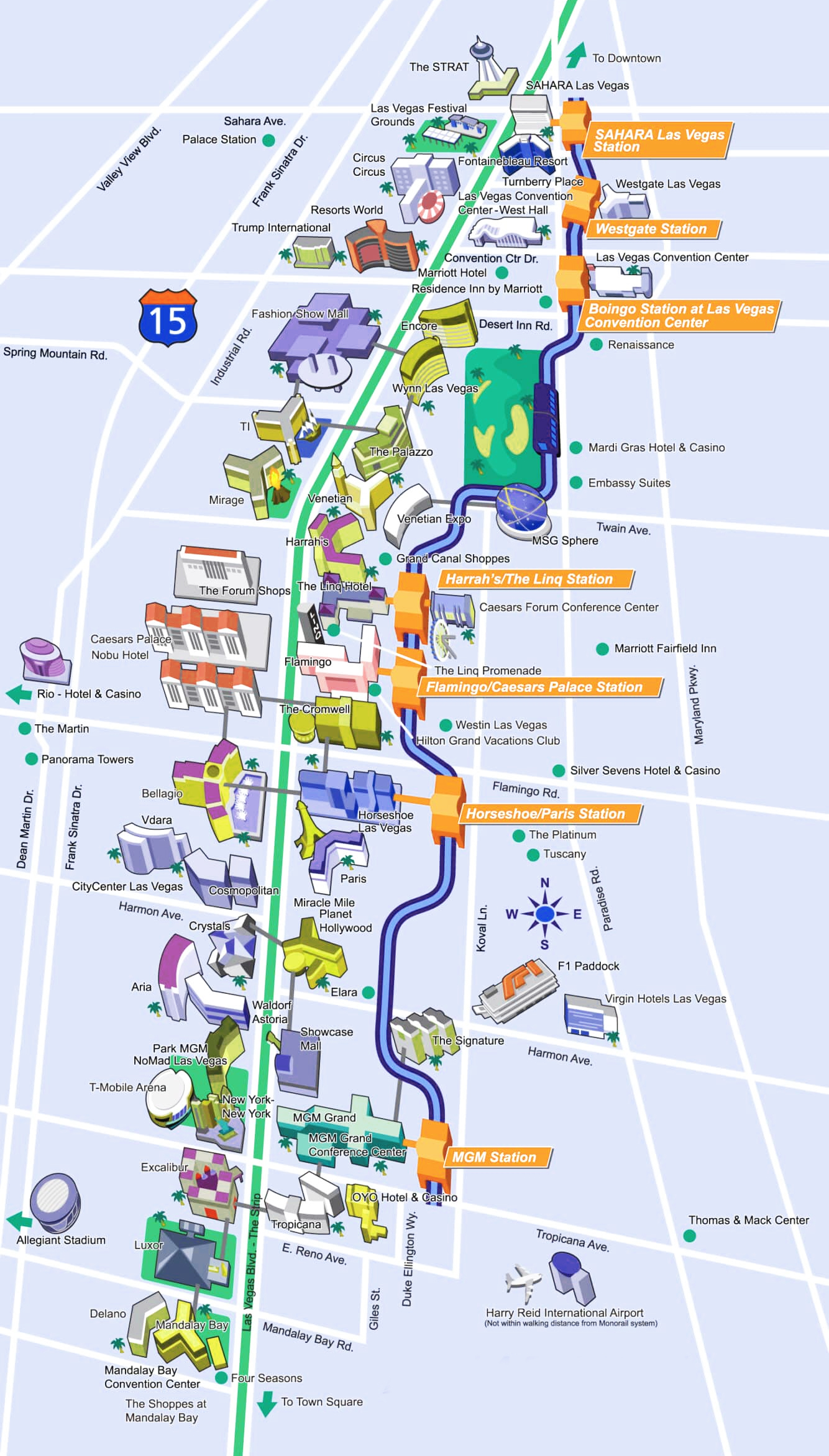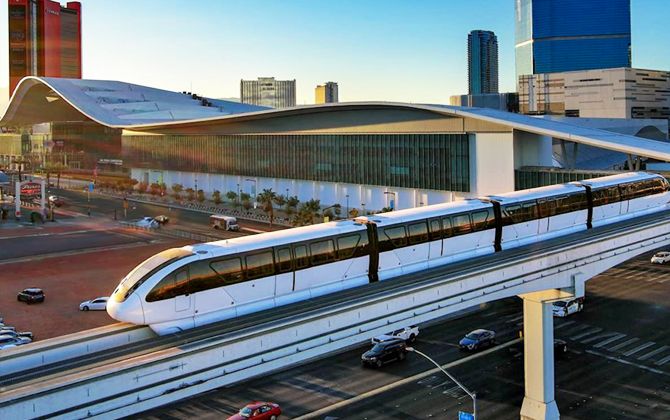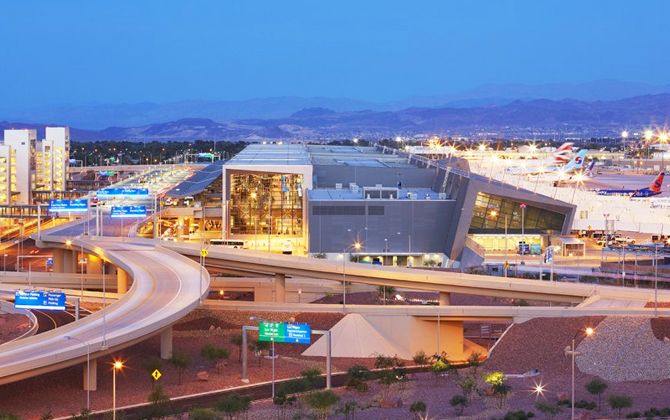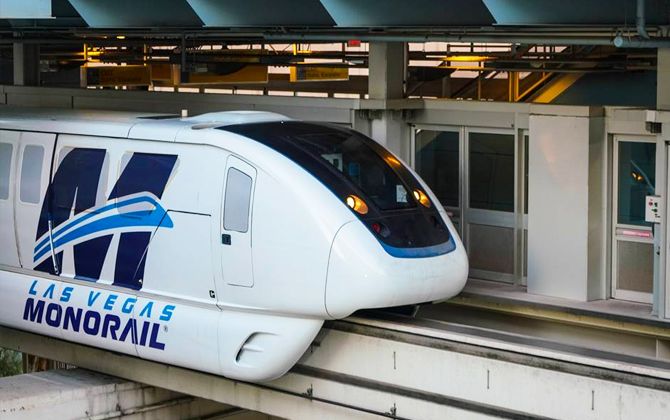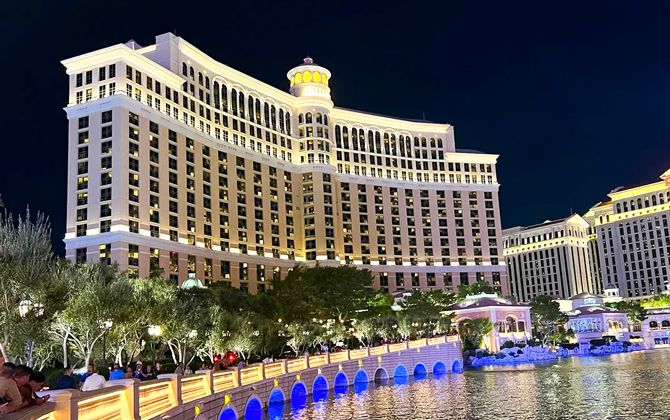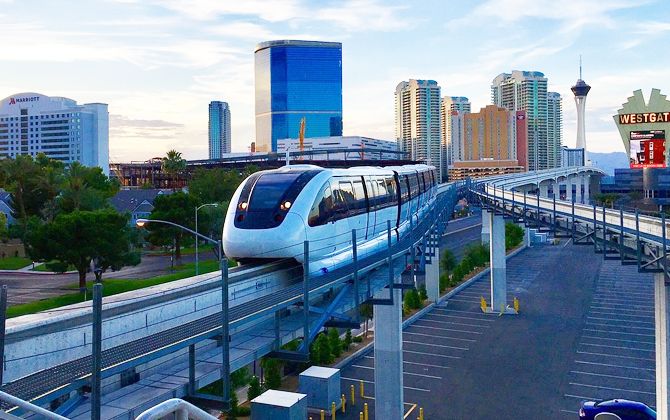The Las Vegas Monorail is a fully automated, electric rapid-transit system that runs along the Las Vegas Strip. It connects major hotels, casinos, and the convention center without traffic delays. The line covers 3.9 miles (≈6.3 km) from Sahara Las Vegas in the north to MGM Grand in the south. The system is powered entirely by electricity.
Metro Map of Las Vegas
The Monorail runs on a double-tracked line with seven elevated stations. From north to south, they are: SAHARA Las Vegas, Westgate, Boingo (Convention Center), Harrah’s/The LINQ, Flamingo/Caesars Palace, Horseshoe/Paris, and MGM Grand.
Map of Las Vegas Metro showing different lines. Click on the map to enlarge it or download the Las Vegas Monorail map in PDF format.
Lines and Stations
Trains run on a 750 V DC electrified guideway at speeds up to 80 km/h (≈50 mph). A full ride takes about 13 minutes. All stations are close to RTC bus stops, including the 24-hour “Deuce on The Strip,” which provides additional north–south service along the Strip.
SAHARA Las Vegas Station: Located at Sahara Las Vegas resort, the north terminus. Close to the STRAT hotel and tower.
Westgate Station: At Westgate Las Vegas (formerly SLS). The resort features an Elvis Presley memorabilia museum and a live-entertainment theater.
Boingo (Convention Center) Station: Inside the Las Vegas Convention Center, with direct access to trade shows like CES, convention halls, and nearby shops.
Harrah’s/The LINQ Station: At Harrah’s Las Vegas and The LINQ. Within walking distance of the High Roller observation wheel and LINQ Promenade. The Venetian with its gondola rides is also a short walk away.
Flamingo/Caesars Palace Station: Above Flamingo Las Vegas casino. Provides access to the Flamingo Wildlife Habitat and hotel gardens, as well as Caesars Palace. The Bellagio fountains are one block north across Las Vegas Blvd, best reached via the Horseshoe/Paris Station.
Horseshoe/Paris Station: Serves Horseshoe (formerly Bally’s) and Paris Las Vegas. Closest stop to the Bellagio Hotel and its free dancing fountains.
MGM Grand Station: At the MGM Grand hotel and casino, the south terminus. Nearby attractions include New York-New York resort and the Big Apple Roller Coaster.
Timetables and Schedule
Operating Hours: Service starts at 7:00 AM every day. Trains run until midnight on Mondays, until 2:00 AM Tuesday–Thursday, and until 3:00 AM Friday–Sunday. Hours may be extended during major events.
Frequency: Trains arrive every 4–8 minutes. During conventions or busy evenings, wait times are closer to 4 minutes.
End-to-End Travel: A full ride from Sahara to MGM Grand takes about 13 minutes.
Pricing
| Ticket Type | Full Fare (USD / EUR) | Online Price (USD / EUR) |
|---|---|---|
| One-Ride Ticket | $6 (≈€5.60) | $5.50 (≈€5.15) |
| 1-Day Unlimited Pass | $15 (≈€14.00) | $13.45 (≈€12.55) |
| 2-Day Unlimited Pass | $26 (≈€24.30) | $23.75 (≈€22.20) |
| 3-Day Unlimited Pass | $32 (≈€29.90) | $29.95 (≈€27.95) |
| 4-Day Unlimited Pass | $39 (≈€36.40) | $37.00 (≈€34.50) |
| 5-Day Unlimited Pass | $47 (≈€43.90) | $44.50 (≈€41.60) |
| 7-Day Unlimited Pass | $62 (≈€57.90) | $57.50 (≈€53.70) |
“Full Fare” applies to tickets purchased at machines. “Online Price” is a discounted rate available for advance eTicket purchases.
Ticket Types
One-Ride Ticket: Valid for one passenger and a single trip from one station to another. The ticket is used once per entry.
Unlimited-Day Passes: Allow unlimited rides for 1–7 consecutive days from first use. Each 24-hour period begins at the time of first entry.
Discounts
- Children aged 5 and under ride free
- Nevada residents with a valid state ID can buy special single-ride tickets for $1 (≈€0.95), limited to two per person per day
- Online eTickets are cheaper than machine purchases.
Connection with the Airport
The Monorail does not go to Harry Reid International Airport. Its southern end is at MGM Grand Station, located about 4–5 km (≈2.5–3.1 miles) north of the airport. Travelers heading to the airport usually get off at MGM Grand and continue by taxi, shuttle, or bus. RTC Route 109 (“Westcliff Airport Express”) covers this short trip in about 6 minutes.
Plans to extend the Monorail to the airport have been proposed but never completed. A 2005 study considered a route from MGM south through UNLV to the airport, but it was never funded.
Regulations
Prohibitions
- Smoking is prohibited on trains and in facilities.
- Passengers are not permitted to enter the driver’s cab.
- Areas reserved for staff, train drivers or machinery are off-limits to passengers.
- Begging is not allowed in stations or on trains.
- Footwear is required for access to facilities.
- Passengers under the influence of alcohol or illegal substances may be removed from the system and fined by the local authorities.
- Passengers are not permitted to distract staff from carrying out their duties.
- Deadly or dangerous objects are not permitted in stations or on trains.
- Oversized items that cause inconvenience to other passengers are not allowed on the system.
- Passengers should occupy only one seat on the monorail. Additional seats should not be used for luggage, bags or other items.
- Personal music players are permitted only if the user is wearing headphones.
- Any form of assault, harassment, intimidation or threat to another user of the system is strictly prohibited.
- Emergency devices should only be used in genuine emergency situations.
- Unauthorised distribution of leaflets or propaganda within the facilities is not permitted.
- Throwing objects onto the monorail track is strictly prohibited.
Precautions
- Passengers should remain behind the yellow line until the train has come to a complete stop.
- To facilitate boarding and alighting, passengers are advised to stand on the platform to the side of the train doors, not directly in front of them.
- It is recommended that passengers wait for the train to stop before disembarking.
- Leaning against train doors should be avoided.
- Do not obstruct the doors as this may cause injury.
Nearby Attractions
Many of Las Vegas’ top attractions are within walking distance of Monorail stations:
Horseshoe/Paris Station: Closest stop to the Bellagio Hotel & Casino. Cross the Strip to see the famous Bellagio Fountains, a free water show set to music.
Harrah’s/The LINQ Station: Next to the LINQ Promenade. From here you can ride the High Roller observation wheel or walk to The Venetian for its indoor gondola rides.
Flamingo/Caesars Palace Station: Located at the Flamingo casino. Nearby is the Flamingo Wildlife Habitat with flamingos and other birds. Caesars Palace, known for its Forum Shops and restaurants, is right next door.
Westgate Station: At Westgate Las Vegas, which features an Elvis Presley memorabilia museum and live shows. It’s a short walk to Wynn and Encore casinos, as well as the Las Vegas Convention Center via pedestrian bridges.
MGM Grand Station: At the MGM Grand Hotel. This stop provides access to MGM’s casino and shows. A walkway connects it to New York-New York, home of the Big Apple roller coaster. Tropicana Las Vegas, with shopping and dining, is also nearby. Allegiant Stadium, home of the Raiders, is about 3.4 km (≈2.1 miles) south of MGM Grand.
Boingo/Convention Center Station: Inside the Las Vegas Convention Center, serving trade shows and exhibitions. The Las Vegas Global Business District, including Sahara, Wynn, and Encore, is just north.
SAHARA Station: At Sahara Las Vegas, the northern terminus. Located one block south of the STRAT Hotel & Casino and close to the Fashion Show Mall.
Each station is built for easy pedestrian access, making the Monorail a convenient way to reach major Strip attractions.
Future Extensions
Despite many proposals, no new monorail routes have been built beyond the original 7-station line. Notable unbuilt plans include:
Downtown (North) Extension: In 2005, Clark County studied a 2.3-mile (≈3.7 km) extension north from Sahara into downtown Las Vegas. The project was canceled due to high costs.
Airport (South) Extension: A 2005 proposal aimed to extend the line south from MGM Grand through UNLV to Harry Reid International Airport. Funding was never secured, and the project was abandoned.
Allegiant Stadium: In 2018, the county approved a 1.2-mile (≈1.9 km) extension to Mandalay Bay near Allegiant Stadium, home of the Raiders. Construction was delayed due to lack of funds and never began.
MSG Sphere/Venetian: Also in 2018, a station near The Sphere (close to Venetian) was proposed to link major convention centers. The plan was never implemented.
Other ideas, such as a west-Strip loop along Frank Sinatra Drive, were considered and dropped. As of 2026, there are no active extension projects. The Monorail continues to operate as the same 7-station east-Strip line.
Fun Facts
- High Ridership: The Monorail serves 5–6 million passengers each year. During large conventions, it can move up to 67,000 riders per event—the same as more than 22,000 taxi trips.
- Electric and Green: Trains run entirely on electricity with zero on-site emissions. Regenerative braking reduces CO₂ output by about 27 tons annually, cutting out 2.1 million vehicle-miles (≈3.4 million km) of driving—roughly nine round-trips to the Moon.
- Fast and Frequent: Trains run every 4–8 minutes and reach speeds of up to 80 km/h (≈50 mph). The full line takes just 13 minutes, often beating any street-level transport when Strip traffic is heavy.
- Safety and Comfort: The Monorail has an excellent safety record and is fully automated. Cars are air-conditioned and offer wide views of the Strip from the elevated track. At night, the neon skyline makes the ride especially scenic.
- Attraction Shuttle: Many visitors find the Monorail more reliable than taxis or buses on the Strip. In some cases, it is even faster than ride-hailing. For example, riding to MGM Grand and then taking a 6-minute car ride can be quicker than sitting in Strip traffic.
History
The Las Vegas Monorail began in 1995 as a short two-station line between MGM Grand and Bally’s. From 2002 to 2004, it was rebuilt and extended north to Sahara Las Vegas. New Bombardier Innovia (Mark VI) trains replaced the original vehicles, and the expanded 3.9-mile (≈6.3 km) line opened on July 15, 2004. The project cost about $650 million (≈€610 million), funded privately.
The Monorail faced financial difficulties for years. It filed for bankruptcy in 2010, and by 2020 the operator collapsed again. That same year, the Las Vegas Convention and Visitors Authority (LVCVA) purchased the system for $24.3 million (≈€22.8 million). Today it operates as a public-benefit transit service. Ridership peaked in 2007 at about 7.9 million annual passengers, declined during the Great Recession, and has since stabilized at around 5–6 million per year.
